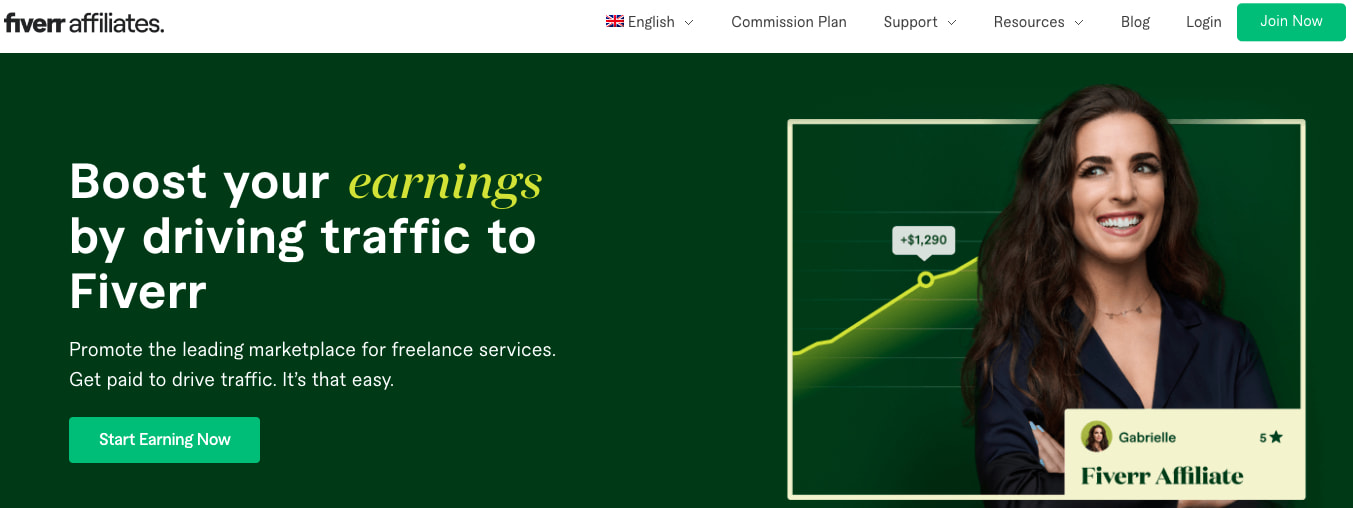What is affiliate marketing and how to get started
Everything you need to know to get started with your own affiliate program
 February 1, 2022
February 1, 2022 8 minute reading
8 minute reading
Imagine getting paid a commission for promoting a company's products or services. That's what affiliate marketing is all about.
Affiliate marketing is a performance-based marketing strategy in which an affiliate earns a commission for each sale they make. The affiliate through a dedicated blog, microsite, video marketing, social media marketing, or even an email newsletter drives traffic to a company's website via an affiliate link and gets paid whenever customers complete a purchase.
This is a monetization and marketing model that benefits both parties. The affiliate can leverage their existing audience and expertise to help another company drive sales and get paid for it. The merchant gets more sales without having to actively market in order to earn them, often keeping acquisition costs low. It's a win-win for everyone involved.
Within this guide, we'll walk you through the key steps for starting your own affiliate program, and successfully promoting it.
Get started with affiliate marketing
1. How does affiliate marketing work?
Affiliate marketing is essentially a pay-for-performance agreement that involves four parties: the merchant, the affiliate network, the affiliate, and the consumer. The affiliate (also known as the publisher) joins a company's affiliation program whether through invitation or by applying online, they'll be given a custom trackable code (often in the form of a personalized affiliate link ) that they'll use to promote a specific product or service. The consumer will click on the affiliate link and ideally take a certain action (which could be a free sign-up, a sale, an event registration, or something else), the affiliate network will record the action, and then the merchant will pay the affiliate the agreed-upon commission.
Let's take a closer look at exactly what this entails.
The merchant. Also called "sellers," "brands," "retailers," or "vendors," this is the party that creates and wants to sell their product. They can be large companies selling their own products, like KitchenAid. It can be a single individual selling online courses. It can also be retailers or vendors like Amazon, who just want to increase overall sales. All they need is a product or service to sell.
The affiliate network. An intermediary between the affiliate and the merchant, the network is responsible to record the payment and handle product delivery. Amazon Associates is a great example of an affiliate network; which also offers a database with plenty of products that the affiliate can use to find products to promote.
The affiliate. In some cases, they are also known as the "publisher," and they can be single individuals or entire companies whose sole purpose is to drive profit through affiliate sales. This is the party that actively markets the product or service and its value, reaching out to their audience in order to drive sales to the merchant's site. Sometimes, affiliate marketers will be individuals who have large followings, like bloggers or YouTubers. In some cases, there will be sites like "This Is Why I'm Broke" that regularly publish affiliate content to an engaged audience.
The consumer. Without the consumer, the affiliate system doesn't work. There are no sales and no commissions. The consumer will typically trust the affiliate's opinion of a product or service, and click to make the purchase. It's essential, however, that they know that they're potentially purchasing a product being promoted with strings attached. A quick disclaimer like "I may receive a small fee if you purchase" is typically all that's needed, but many affiliates are much more upfront.
2. Types of affiliate marketing
There are really three core types of affiliate marketing. Let's take a look at each one.
Unattached affiliate marketing
This is an advertising model where the affiliate has absolutely no connection to either the product or service that they're promoting, including having no known related skills or experience. They're not an authority. There isn't a duty of recommending or advising a product; they're essentially just listing product ads.
It's possible to run ads for products through Amazon's affiliate market without actually advertising products that you're selling yourself. Someone with a ton of ad experience may know how to create engaging ads that drive sales and earn them a profit. This is an example of unattached affiliate marketing.
Related affiliate marketing
In this affiliate model, the affiliate is related to the product or service in some way but not entirely involved with it. They may be an authority in the product industry. Their authority is often what makes them a trusted source, though they'll make no claims about the use of the product or service.
An example might be a blog post with a topic like "10 Wardrobe Items You Need Before You Turn 30" and linking to affiliate items they find online. In this case, the article isn't raving about those specific items; instead, they're only showing them as potential examples of the items being discussed.
Involved affiliate marketing
This is perhaps the most common type of affiliate marketing, and it's the most impactful for affiliates with a large base when it comes to driving sales quickly. It involves the affiliate actively promoting specific items, with the assumption that the affiliate has used and is vouching for the product at hand.
A well-known beauty YouTuber, for example, would be able to recommend products with authority, demonstrate them in use, and likely be able to drive a significant chunk of affiliate sales. This is that deep connection; she's showing you the product in use and talking about why she loves it.
While this can be effective, influencers may need to be careful here. They need to make sure that they're only recommending high-quality products relevant to their audience, or their audience will stop trusting them and won't buy again (and may even unsubscribe) in the future.
3. Benefits of affiliate marketing
In most cases, affiliate marketing is typically well worth the time and effort on both the merchant's and the affiliate's part.
Especially considering the benefits for both parties involved. Merchants gain access to affiliates who are professional marketers or experts with engaged audiences. The amount they pay affiliates in commission is often less than what they would have spent on other types of acquisition costs, including PPC campaigns. The potential ROI at the end of the day, is incredible, especially considering they didn't need to take on any of that marketing effort themselves.
These are the most significant benefits to consider:
There are little or no startup costs. It costs very little to start an affiliate program. The most substantial cost would be if you want to use affiliate software to track sales and automate the process, which many brands prefer to do.
The commissions are low-cost and predictable. Aside from the ongoing affiliate software costs, the only extra costs will often be affiliate commissions. And all things considered, these commissions are typically much more cost-effective than other customer acquisition methods, such as PPC. They're also predictable because you know exactly what you'll pay for each customer or sale.
The commission rates are low risk and tied to real action. In addition to being relatively low cost, commission rates that you would pay out to affiliates are low risk because you're only paying when the desired action is completed. There's no paying for PPC clicks that never amount to conversions, or paying for sponsored posts that might not even be read. You're paying for performance, and that helps protect your bottom line.
You get to control who is an affiliate. While anyone can purchase your products, the reality is that you may not want some people promoting your product if you don't feel they represent your brand well. A children's educational company, for example, might not want a blog that regularly uses profane language and writes disparagingly about their own children to mention that the educational games are great, because they don't want to be associated with that blogger. With an affiliate program, you can deny any affiliate applicants that you'd like to protect your brand image. This, in turn, means that you're able to work with affiliates who are most likely to bring you targeted, relevant traffic.
Affiliate posts double as UGC. User-generated content (UGC) is one of the most powerful types of advertising media out there. Affiliate promotions are automatically doubling as UGC because users are seeing someone other than the merchant promoting the content. In addition to being powerful when placed on the affiliate's own site, you can also reuse this content (with permission!) on your own social media feeds, too.
Increase your brand's reach and awareness. Affiliate marketing allows you to reach other individuals' highly engaged and often loyal followings without any extra effort on your part (and just for a small fee). This is a fast and easy way to increase your brand's reach and your overall brand awareness fast.
You can choose the speed of growth and the size of your program. Want to recruit as many affiliates as possible? Go for it. You can also choose to handpick and reach out to no more than five individuals you're familiar with to act as affiliates if you so choose. You're in complete control, which can make it easier for you to plan financially and to scale at your chosen speed.
The costs are low and profit is high. Affiliate marketing programs typically have extremely low startup costs, and in many cases, the commission you're paying affiliates is less than what you'd pay through other channels. This results in higher-than-average ROI compared to other marketing platforms or tactics, partially because faster conversions happen when users trust the affiliates.
4. Examples of affiliate marketing
Small and large businesses alike have affiliate marketing programs. To better understand how affiliate marketing programs can work, let's take a look at two different well-known examples and what's involved in the process.
Amazon Associates
Amazon has a well-known affiliate program that you've almost definitely seen "in the wild" without realizing it. Many third-party articles that link out to products directly on Amazon are often participating, including affiliate links for potential passive income.
Amazon's affiliate marketing program is called "Amazon Associates," and it's one of the largest programs in the world. Affiliates sign up online to share Amazon products on their website, app, blog, or YouTube channel. When users click on those links and convert, they receive a percentage of the sale.
Amazon is strict about who can join the program. The site's content all must be original (a.k.a. not plagiarized in any way), and the site must be viewable by the public, active, and "suitable" according to Amazon's standards. This means that sites containing offensive, obscene, violent, illegal, or otherwise harmful content can't participate. Amazon will review sites before approving them.
Once approved, affiliates will need to meet a certain sales quota in order to stay in the program. This is three sales within 180 days of application. If they're rejected, they're not going to be eligible for reconsideration.
Commissions are earned as soon as site visitors purchase products or services from Amazon, and affiliates can get up to 10% in commissions off the item's sale price. Affiliates can see what commission rate they'll receive when browsing products in their database. They may be able to earn extra commission on some products or during special events.
Here's the basic process:
A site owner created an Amazon Affiliate account to apply to become an affiliate
If approved (and approval is typically fast), Amazon gives each affiliate a unique Associate ID
Associates can begin creating affiliate links in their Amazon Affiliate account
These links are placed in blog posts or other parts of their site
When someone clicks the link to make a purchase, the associate earns a commission almost instantly

Fiverr Affiliates
Fiverr affiliates reward affiliates for driving traffic to the site that results in first-time buyers (FTB) and recurring orders. Affiliates can earn up to $1000 USD for a single FTB conversion while promoting any of the 500+ categories present within the marketplace or other Fiverr services like Fiverr logo-maker, Fiverr learn, or Fiver Pro.
Some of the commissions currently include:
CPA commission of $15 - $150 for Fiverr services like freelance writing, developing, or video creation
A fixed CPA of $10 per first-time purchase and 10% Revenue Share for 12 months
Fiverr Learn: 30% of every Fiverr Learn course
Fiverr Workspace: 50% of every Unlimited plan of Fiverr Workspace
Fiverr Pro: $100 CPA once the account reaches $100 in spend + 10% RevShare for 12 months
Fiverr Affiliates: 10% of every referred affiliate’s earnings for a lifetime
Unlike most affiliate programs, affiliates don't actually have to have a website in order to become an affiliate. They can apply through Fiverr's affiliate site to create an account (which is separate from an existing Fiverr user account). This process will involve explaining how they're planning on promoting Fiverr.
Product and service links (which can be promoted to people in 160 different countries) contain a 30-day cookie, and if a registration event converts within 30 days after first clicking on their link, then the attribution locks under their account. In fact, once registered the attribution is for life, Fiverr attributes the traffic based on the last click that leads to registration. And for those who want to take advantage of deep linking, that's entirely possible; affiliates can use deep linking to send users to specific product pages for faster checkouts and conversions.
There's also a large portfolio of high-performing marketing tools like the Search Box widget and the Fiverr Gig Ads Widget to make this process easy and hopefully profitable.
Fiverr's affiliate program offers professional support and a dedicated affiliate manager, making the process easier for affiliates who want to get started.

5. How to start an affiliate program
If you want to take advantage of affiliate marketing as a business, get started setting up your merchant affiliate program. This is easy to do, and we'll walk you through the five steps you need to create your new program.
1. Determine which products & services you want to include in your program
This is a crucial part of setting up an affiliate program: deciding exactly what you want to be eligible for in terms of the products and services that you sell.
You can include all of your products if you'd like. Some businesses do this. But, in many cases, it may be best to start with a few product ideas that are the most popular with your existing audience, or that could scale well. Even if this is only one or two products or services, that's okay! Choosing high-profit products that you want to promote heavily is also a good choice.
You can include physical products, digital products (including SaaS tools or online content), event registrations, educational materials, and services as part of your program.
There's always the option to add more products to your program at any time, so don't worry about starting small; you can scale as quickly as you'd like.
2. Choose your commission models
How are you going to pay affiliates, and what exactly will you pay?
Are you going to pay them a flat rate, like $30 for every person who purchases a ticket to your event? Or are you going to offer them 15% of the customer's first purchase from your business? Some businesses prefer flat rates because they're easy to calculate and track; others utilize percentages for a number of reasons, including that it may encourage the affiliate to push higher-cost products or services.
Most affiliate commissions are going to range from 5-15%, though it can go up to 30-50% depending on the program.
The most important thing to balance here is finding a number that will be worth it to the affiliate while still keeping your business profitable. It's okay to take a loss on a one-time purchase if the majority of these customers come back and purchase again, retaining for a longer lifecycle, so factor that into the equation, too.
3. Select an affiliate management platform
Theoretically, you could manually try to track affiliate sales using URL codes, but that's almost definitely not worth the time and effort and it's easy to make mistakes. The best thing you can do is invest in some sort of affiliate software.
If you want to have a small program, you can take advantage of free or low-cost plugins or apps that work with your CMS platform to track this for you. You can also use more specialized affiliate software that gives you an up-close look and that comes with plenty of customization and advanced features like automatic payouts.
Think about what's best for you, and don't forget to factor the cost of these tools into the overall cost of your affiliate program. No matter what, choose a tool that can help you track the following for individual affiliates:
Conversions made
Commissions paid
Commissions owed
Affiliate links
Clicks on the link (with or without conversions)
4. Generate supportive marketing materials
While a huge advantage of affiliate marketing is how hands-off it can be, taking a few extra steps to offer some marketing materials to your affiliates can mean that your program will be much more successful.
Examples of marketing materials that you might create for your affiliates include:
High-quality product images or videos
Product demos
Brand guides discussing the best features of the product or how to use it
Brand guides detailing how you do and do not want affiliates to discuss your product (which may include certain language to enhance or protect your brand)
Email, social media, or even blog post templates that they can use to quickly create content to sell your products the way you would
5. Start recruiting your affiliates
Once everything else is in place, you can start promoting your program so you can begin to recruit affiliates.
The first step for many merchants will be to create a dedicated landing page sharing the details of the affiliate program, which will exist on their site. Many choose to have an "Affiliate" link in the header or footer of their site.
You can also share on social media and through email that you have a new affiliate program.
When you first get started, proactively reach out to your network or to individuals in the industry who you believe would be interested. This is a great way to start to gain traction, explaining clearly what the potential commission rates are and how to get started.
6. How to promote your affiliate marketing program
Your affiliate marketing program will only take off if potential affiliates actually know that it exists. Let's take a look at a few simple but reliable strategies that will help you promote your affiliate program so you can start recruiting people quickly.
Leverage your email list
The first thing you should do when you launch an affiliate program is to send an email to your list right away. There are likely going to be customers who are already using your tool that may have some sort of platform that would make them incredible affiliates.
You might have a freelance writer, for example, who is a passionate customer of your invoicing tool. If you recruit them, they may be able to place affiliate links in relevant posts on their own blog that teaches other writers how to excel in freelancing.
Create a short email letting your customers know that you've launched an affiliate program and that you're hoping they'll consider joining. Share the commission rates and what's involved, and you can always point out that it's not an MLM requiring recruiting for good measure.
Share it on social
This follows the same basic principle as reaching out to your email list; you want people who are already engaged with your brand to know about this opportunity. And on social media, people are more likely to share it with others they think would find it relevant. This can expand your reach quickly, and it can be searchable on each individual platform.
If users have any questions, they'll also typically ask directly in the comments. That's a great place to overcome objections and encourage users to sign-up.
Submit your program to directories
There are actually plenty of affiliate marketing program directories online that influencers and bloggers regularly use to find affiliate opportunities to sell more. A quick Google search will reveal an enormous list of directories that you can choose from, and submitting your program is often free or low-cost.
This strategy can help introduce your brand and affiliate program to users who have never heard of you before but who could be a great fit to work as affiliates.
Reach out to industry experts
While industry experts are often inundated with all sorts of requests regularly that ask for favors, they might actually be interested to learn about real money-making opportunities that could benefit them.
Some influencers or industry experts actually make a significant amount of income from affiliate marketing, especially if they have a large and engaged audience. Reach out to them directly, explaining that you love what they do, that you'd love for them to be an affiliate, and explaining what's in it for them. You can reach out through their site or on LinkedIn, and always make sure you thank them for their time.
Look for partnership opportunities with other businesses and websites
You want to get the word out about your products; so do other businesses and websites.
If you find a complementary business online that also has an affiliate program, you could have a great opportunity for a powerful collaboration.
A graphic design agency, for example, might promote an advertising agency on their site for customers who want help with ad creation. That same agency can promote the graphic design agency and refer customers back their way. Both businesses are benefiting. Ultimately, the customers will see that there are strong partnerships in place which can build the trust they have for both businesses since no business would risk their reputation for another by recommending someone who wasn't great.
Treat it like a brand ambassador program
The strategy to identify your most loyal and enthusiastic customers to promote your business for you while sending some commission money their way is a good one. You can always reach out directly to high-value customers who have been vocal about their great experiences with your brand in the past and see if they're interested in being an affiliate. You never know who might say yes.
Never spam & always follow the rules
You can technically join affiliate marketing forums and related groups on Facebook or LinkedIn, but it's essential that you always follow group rules and never spam your link. This is a good way to get people angry and to get banned. Instead, if someone ever raises the topic or has a "promote your business" thread, that's yours in.
The conclusion: affiliate marketing is an outstanding opportunity
Affiliate marketing has become one of the most popular online strategies today for businesses of all sizes to drive sales and generate revenue. In fact, referring to Backlinko 40% of U.S. merchants reveal affiliate programs being at the top of their customer acquisition channel in 2022.
Building your own affiliate program doesn't require you to put in much effort to market your products, or to spend thousands of dollars on advertising. Whether you are a large company, or a single individual selling products or services affiliate marketing offers great opportunities mainly because it's a commission-based strategy where actually payments are only made when a sale takes place.


